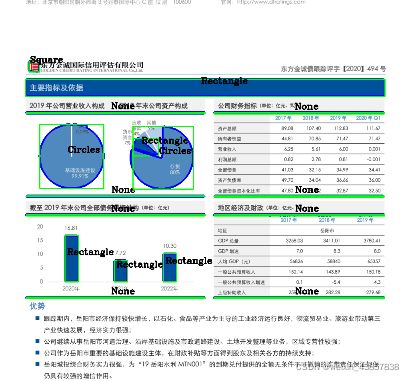def getContours(img):
for cnt in contours:
area = cv2.contourArea(cnt)
print(area)
if area>500:
cv2.drawContours(imgContour, cnt, -1, (255, 0, 0), 3)
peri = cv2.arcLength(cnt,True)
approx = cv2.approxPolyDP(cnt,0.02*peri,True)
print(len(approx))
objCor = len(approx)
x, y, w, h = cv2.boundingRect(approx)
if objCor ==3: objectType ="Tri"
elif objCor == 4:
aspRatio = w/float(h)
if aspRatio >0.98 and aspRatio <1.03: objectType= "Square"
else:objectType="Rectangle"
elif objCor>4: objectType= "Circles"
else:objectType="None"
cv2.rectangle(imgContour,(x,y),(x+w,y+h),(0,255,0),2)
cv2.putText(imgContour,objectType,
(x+(w//2)-10,y+(h//2)-10),cv2.FONT_HERSHEY_COMPLEX,0.7,
(0,0,0),2)
path = "Resources/majiang2.png"
img = cv2.imread(path)
imgContour = img.copy()
imgGray = cv2.cvtColor(img,cv2.COLOR_BGR2GRAY)
imgmedianBlur = cv2.medianBlur(img ,5)
imgBlur = cv2.GaussianBlur(imgGray,(7,7),2)
imgCanny = cv2.Canny(imgmedianBlur,50,300)
getContours(imgCanny)
imgBlank = np.zeros_like(img)
imgStack = stackImages(0.4,([img,imgGray,imgBlur],
[imgCanny,imgContour,imgBlank]))
cv2.imshow("Stack", imgStack)
cv2.waitKey(0)

输出图片的代码
def stackImages(scale, imgArray):
rows = len(imgArray)
cols = len(imgArray[0])
rowsAvailable = isinstance(imgArray[0], list)
width = imgArray[0][0].shape[1]
height = imgArray[0][0].shape[0]
if rowsAvailable:
for x in range(0, rows):
for y in range(0, cols):
if imgArray[x][y].shape[:2] == imgArray[0][0].shape[:2]:
imgArray[x][y] = cv2.resize(imgArray[x][y], (0, 0), None, scale, scale)
else:
imgArray[x][y] = cv2.resize(imgArray[x][y],
(imgArray[0][0].shape[1], imgArray[0][0].shape[0]), None, scale,
scale)
if len(imgArray[x][y].shape) == 2: imgArray[x][y] = cv2.cvtColor(imgArray[x][y],
cv2.COLOR_GRAY2BGR)
imageBlank = np.zeros((height, width, 3), np.uint8)
hor = [imageBlank] * rows
hor_con = [imageBlank] * rows
for x in range(0, rows):
hor[x] = np.hstack(imgArray[x])
ver = np.vstack(hor)
else:
for x in range(0, rows):
if imgArray[x].shape[:2] == imgArray[0].shape[:2]:
imgArray[x] = cv2.resize(imgArray[x], (0, 0), None, scale, scale)
else:
imgArray[x] = cv2.resize(imgArray[x], (imgArray[0].shape[1], imgArray[0].shape[0]), None, scale,
scale)
if len(imgArray[x].shape) == 2: imgArray[x] = cv2.cvtColor(imgArray[x], cv2.COLOR_GRAY2BGR)
hor = np.hstack(imgArray)
ver = hor
return ver
